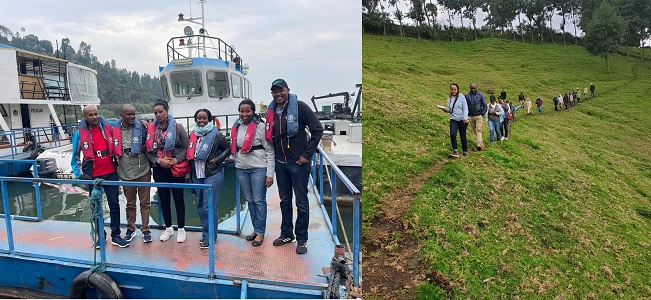
Members of the Rwanda Environment Management Authority (REMA) Board of Directors have concluded a three-day field visit conducted in the intervention zones of different projects implemented by REMA.
The Board members, accompanied by REMA’s Director General, Juliet Kabera and Deputy Director General, Faustin Munazikwiye started their field visit in Kamonyi District on 17th August 2022 by visiting interventions of the Forest Landscape Restoration in Amayaga Region commonly known as Green Amayaga Project.
The interventions include roadsides protection (Rugobagoba – Mukunguli road) and afforestation activities, agroforestry plantation and macadamia plantation among many others. The Board members also interacted with Green Amayaga Project beneficiaries including owners of macadamia plantation and forests planted by the Project as well as beneficiaries provided with improved cookstoves.
“All of these interventions clearly show how Green Amayaga Project is building resilience to climate change for communities in Amayaga region” noted members of REMA’s Board of Directors commending efforts invested in the implementation of the Project activities.
Apart from visiting Green Amayaga Project interventions, the members of REMA’s Board of Directors also visited the Landscape Approach to Forest Restoration and Conservation (LAFREC) Project. With support of Nyabihu District officials, they toured LAFREC interventions including Silvopastoralism activities and the Water supply system established by LAFREC Project in Bigogwe Sector of Nyabihu District.
Introducing silvopastoralism approaches was among the project’s components to improve livelihoods of beneficiaries around Gishwati-Mukura National Park.
Silvopasture is a tree-based livestock production system, where trees, shrubs and other vegetation planted on pasturelands provide fodder as well as other multiple benefits.
“Silvopastoralism has become an answer to serious problems farmers were facing related to low milk production. LAFREC Project supported by providing livestock to farmers around the park, and making paddocks in farms at the instance that we now have control over grazing” farmers in Gishwati told Members of REMA’s Board of Directors.
You can also see trees around the rangelands, some of them provide shelter for our livestock in dry season, while some other species (mainly Cystisus proliferus, Sesbania sesban and Leucaena leucaocephala) are fodder for our livestocks” farmers added.
Members of REMA’s Board members concluded their field visit by visiting the Lake Kivu Monitoring Project. They visited the existing gas extraction plants in Lake Kivu, toured the lakeshores to see how they are protected thanks to inspection missions conducted by REMA, and visited the Lake Kivu Monitoring Laboratory to witness how how the lake is regularly monitored for its safety, the biodiversity it hosts and surrounding communities.
This field visit is in line with REMA’s Board of Directors’ responsibilities to evaluate the performance of REMA in accordance with its plan of action and budget.
REMA’s Board of Directors is mandated to govern decision making within REMA, and has full power and responsilities to manage REMA in order to fulfill its mission. (End)
